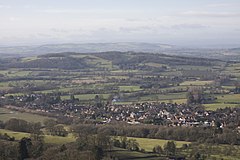Colwall: Difference between revisions
typo corrected: "I890" changed to "1890" |
Rick marin (talk | contribs) mNo edit summary |
||
| Line 34: | Line 34: | ||
Near to the station is the mock [[Georgian architecture|Georgian]], country house style Colwall Park Hotel, purpose built in 1905 to serve the now defunct Colwall Horse Racecourse. |
Near to the station is the mock [[Georgian architecture|Georgian]], country house style Colwall Park Hotel, purpose built in 1905 to serve the now defunct Colwall Horse Racecourse. |
||
Colwall has a [[primary school]]. There are two preparatory schools in the village, ''[[The Downs School (Herefordshire)|The Downs]]'' and ''[[The Elms School|The Elms]]'', founded in 1614. |
Colwall has a [[primary school]]. There are two preparatory schools in the village, ''[[The Downs School (Herefordshire)|The Downs, Malvern College Prep.]]'' and ''[[The Elms School|The Elms]]'', founded in 1614. |
||
Colwall has expanded in the past ten years with the development of "Pedler's Field" and other parts of the village. |
Colwall has expanded in the past ten years with the development of "Pedler's Field" and other parts of the village. |
||
Revision as of 19:59, 3 November 2009
| Colwall | |
|---|---|
 View over Colwall Stone | |
| Population | 2,433 (2001) |
| OS grid reference | SO756425 |
| Unitary authority | |
| Ceremonial county | |
| Region | |
| Country | England |
| Sovereign state | United Kingdom |
| Police | West Mercia |
| Fire | Hereford and Worcester |
| Ambulance | West Midlands |
Colwall is a large rural village and civil parish in Herefordshire, England on the border with Worcestershire, nestling into the side of the Malvern Hills. Different parts of the village are known as Colwall Stone, Upper Colwall and Colwall Green along over a mile of the B4218 road. The distinguishing view from Colwall is that of the Iron Age British Camp (Herefordshire Beacon), which forms part of the Malvern Hills. Although neither administered by the nearby town of Malvern nor the Malvern Hills District, Colwall is often included in the informal region referred to as The Malverns for the hills, and the towns and villages that surround them.
Colwall is well known as a sporting village, the main focus being on cricket. Colwall contains the largest cricket ground in the county. It is also considered to be the home of women's cricket in England: the Women's Cricket Association was founded in Colwall in 1926, and a Women's Cricket Week is held there every year. The Horton brothers, Joseph and Henry, who both played first-class cricket for Worcestershire – Henry went to greater fame with Hampshire – came from Colwall.
Malvern Water, bottled in Colwall, has formed a part of the national heritage and culture since Queen Elizabeth I made a point of drinking it in public in the 16th century, and Queen Victoria refused to travel without it.[1] It was mentioned in 1622 in Bannister's Breviary of the Eyes:[2]
A little more I'll of their curing tell.
How they helped sore eyes with a new found well.
Great speech of Malvern Hills was late reported
Unto which spring people in troops resorted.
It was first bottled in 1851 and sold as Malvern Soda and then as Malvern Seltzer Water from 1856. In 1890, Schweppes entered into a contract with a Colwall family, and built a bottling plant in 1892. The actual source of the spring spring is on the western side of the hills in Herefordshire. The factory is now owned by CCSB Ltd. (Coca-Cola & Schweppes Beverages)[3] and employs 25 people who bottle 12 million litres annually.
..."The Malvern water says Dr John Wall is famous for containing just nothing at all"...![4] In 1987 Malvern gained recognition as a Natural Mineral Water, a mark of purity and quality. Malvern Water is the only bottled water used by Her Majesty, Queen Elizabeth II, which she takes on her travels around the world.[5].
The village is served by a railway station, just one platform, on the single track line between Great Malvern and Ledbury railway station at Ledbury, which passes through the Colwall Tunnels dug under the Malvern Hills between 1856 and 1860.
Near to the station is the mock Georgian, country house style Colwall Park Hotel, purpose built in 1905 to serve the now defunct Colwall Horse Racecourse.
Colwall has a primary school. There are two preparatory schools in the village, The Downs, Malvern College Prep. and The Elms, founded in 1614.
Colwall has expanded in the past ten years with the development of "Pedler's Field" and other parts of the village.
Colwall has a grocery shop, a fruit & veg shop, a butcher's shop, a chemist, an estate agent, a cake shop, a Thai restaurant, and several pubs and churches. Its post office closed in 2007, but a new post office (housed within the former chemists) was opened on Mon 23 June 2008, sponsored by Colwall Parish Council.
Legend has it that the Colwall Stone was rolled down from the Malvern Hills by a giant whose footprint can be seen to this day on the slopes of the British Camp.
References
- ^ Hansard HC Deb 15 February 1983 vol 37 cc268-74
- ^ F. N. L. Poynter: Notes on a late Sixteenth-Century Opthalmic Work
- ^ CocaCola Malvern water web page. Retrieved 20 May 2009
- ^ Dr John Wall (1756): Experiments & Observations on the Malvern Waters
- ^ http://malvern.whub.org.uk/home/mhcindex/mhc-businit/mhc-businit-exper0ience/mhc-businit-cocacola.htm Malvern Hills District Council. Retrieved 20 May 200
External links
- Colwall web site
- St. James and All Saints Church
- Colwall Park Hotel
- Colwall Rotary Club website
- Colwall Cricket Club
- Beau Thai Restaurant
- Sally Beds B&B
